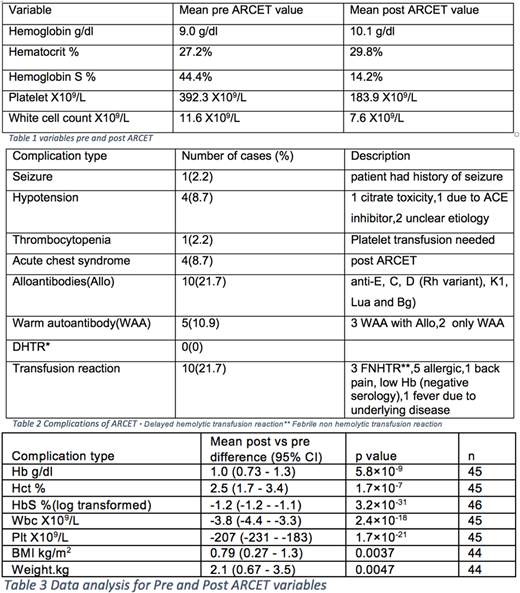Abstract
Background. Automated red cell exchange transfusion (ARCET) is commonly used in patients with sickle cell disease, but objective data on its impact on acute and chronic complications are limited.
Methods. Fifty-two sickle cell disease patients at the University of Illinois at Chicago underwent exchange transfusion from January 2011 to January 2016. Six patients were excluded due to incomplete data leaving 46 patients available for analysis. We collected data from the year before, year after and the year of ARCET to study the impact of red cell exchange on clinical, biological and hematological parameters.
Results. There were 435 procedures with average of 9.45 per patient (range 4-14). The mean age of our cohort was 58.2 years. There were 22 (47.8%) males and 24 (52.2%) females. Genotypes include 42 (91.3%) HbSS, 1 (2.2%) HbSC, 1 (2.2%) HbSBeta+thalassemia and 2 (4.3%) HbSBeta0thalassemia. The most common indication for ARCET in our cohort was prior stroke in 32 patients (69.6%) and prevention of stroke in 7 patients (15.2%), followed by frequent vaso-occlusive crisis (VOC) 8 patients (17.4%), multiple acute chest syndrome 6 patients (13%), pulmonary hypertension 6 patients (13%) and chronic kidney disease 5 patients (8.9%). Iron overload, sickle hepatopathy, cardiomyopathy and seizure were some of the other indications. Twenty-five patients (54.3%) had more than one indication to undergo the ARCET. Thirty-one patients (67.4%) are still continuing the treatment. Thirty patients (65.2%) were on hydroxyurea (HU) prior to ARCET and 8 patients (17.4%) were still on HU while on ARCET. The mean frequency of ARCET was every 6 weeks. The mean pre and post ARCET values for hemoglobin(Hb), hematocrit (Hct), Hemoglobin S %(HbS), white cell count (wbc) and platelets(plt) are shown in Table 1. Paired t-test and Wilcoxon signed-rank test were used to analyze the clinical and hematological parameters. Analysis shows increase in mean Hb and Hct post ARCET and decrease in mean wbc, plt and HbS % post ARCET and the difference is statistically significant. (Table 3). Post ARCET body mass index (BMI) and weight are increased and the difference is statistically significant with p value 0.002 for BMI and 0.003 for weight. (Table 3). Ten (21.7%) patients showed decrease in the ferritin level post exchange. Thirty patients (65%) had VORTEX port whereas 29 patients (63%) had central venous access for procedures prior to Vortex placement (17/29, 59%). Nine patients (20%) had peripheral access mostly power port (for access) with one peripheral vein for return (6/9 67%). There were 10 access related complications and there were 3 port replacements due to septum damage and infection. There were 10 procedure related complications and 10 transfusion reactions as described in Table 2. ED admissions were decreased in 13(28.3%) patients from mean 7.69 to 2.92 admissions. The annual inpatient admissions showed a decrease in 18(39.2%) patients from mean 4.6 days pre ARCET to 1.6 admissions post ARCET. The acute care admissions showed an increase due to program expansion of our acute care center during this study period.
Discussion. Our study shows that red cell exchange is an effective treatment modality for patients with sickle cell disease. It contributes to improvement in weight, increase in Hb and Hct and decrease in wbc, plt, HbS% and iron overload. It also decreases inpatient and ED admissions. The procedure is safe and tolerable with minimal complications. Long term studies are needed study the efficacy of this treatment modality and its contribution to improvement of quality of life and life expectancy in sickle cell disease patients.
No relevant conflicts of interest to declare.
Author notes
Asterisk with author names denotes non-ASH members.


This feature is available to Subscribers Only
Sign In or Create an Account Close Modal